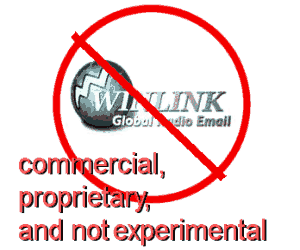Winlink
Winlink for Amateur Radio
The Winlink message system uses a worldwide radio system and amateur-band frequencies to provide radio interconnection services that include email with attachments, position reporting, weather bulletins, emergency relief communications, and message relay. The system is built and administered by volunteers and administered by the Amateur Radio Safety Foundation Inc. Unfortunately, they did not build the system to be cross-platform and it is not open source.
As the name suggests, this sketchy software was written operating system dependent based around the Microsoft Windows operating system. This is not in the spirit of amateur radio as it is not an open source platform.
Winlink requires the Microsoft .Net Framework to run on a personal computer. This is also not in the spirit of amateur radio since .Net is not cross-platform.
The amateur radio community should boycott Winlink. In fact, Winlink should not be permitted on amateur radio frequencies by the FCC. Winlink uses a commercial modem to provide HF eMail service that has been available on commercial frequencies for a very long time. The PACTOR III commercial modem technology is not ham frequency friendly. The use of this digital mode on HF causes harmful interference to other amateur radio communications.
"The interference issues related to WinLink on HF are partly due to the commercial PACTOR III modem having no provision for detecting any kind of signal except other PACTOR signals, partly due to the WinLink administrator specifying that all automated WinLink servers on HF turn off the little bit of signal detection the modem does have, and partly due to the PACTOR III signal automatically causing itself to spread out wider in reaction to improved band conditions - the exact opposite of good operating practice within amateur radio's shared spectrum. Ham radio QSO's which are fortunate enough not to be overwhelmed by the initial PACTOR III transmissions are then enveloped when the signal widens, without the WinLink server operator's knowledge or intervention."
Winlink is the scourge of HF digital modes, often interrupting legitimate ham digital communications such as PSK31.
source: http://www.eham.net/ehamforum/smf/index.php?topic=10110.0;wap2
Read further regarding the pitfalls of Microsoft .Net Framework, which is the programming toolbox for the novice entry level programmer.
FCC CORRECTS PACTOR III: The FCC moved to correct an error which would have rendered J2D emissions illegal below 30MHz. J2D emissions take place in the CW portion of the amateur bands, and are much wider than CW. Further, the practices of PACTOR operators don't lend themselves well to the spirit or intent of ham radio: band sharing, courtesy, and non-interference with other hams.
FCC WT Docket 04-140 discussed how the ARRL argued that a 500-Hz bandwidth limitation in the definition of data emissions would have unintended consequences because the limitation would also apply to Amateur Radio bands where a higher bandwidth is allowed. The ARRL should not be advocating for PACTOR III acceptance. Effective December 15th, 2006, the US FCC has ELIMINATED Pactor 3 use on 80 meters. Therefore, NO US Licensed PMBO will have use of Pactor 3 on the 80 meter band, and will only provide Pactor 1 and Pactor 2 on the 80 meter band. Reason: the US VOICE BAND OPERATION was expanded to cover up FCC PART 97.221 on 80 meters.
Winlink and PACTOR have long been on the fringe of what is allowed in amateur radio.
